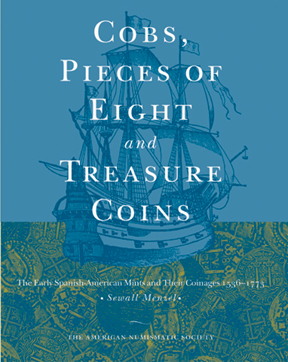
|
COBS, PIECES OF
EIGHT AND TREASURE COINS
The Early
Spanish-American Mints
and Their Coinages
1536—1773
By Sewall Menzel
(Published by the
American Numismatic Society, 2004)
As the leading English
language work in the field, the book has
some 484 referenced (Archives of the
Indies, Seville, Spain, etc.) pages and
over 4,000 photos and diagrams covering
the ten early Spanish colonial mints in
the Americas (Mexico, Santo Domingo,
Lima, Potosí, Santa Fé de Bogotá,
Cartagena, Cuzco, Panamá, Guatemala, and
Cuba) and their coinages: 1536—1773. The
Numismatic Literary Guild's choice as
the best specialized book in world coins
(2005), it is in use by dealers,
collectors, auction houses, museums,
treasure hunters, historians, and
nautical archaeologists the world over.
To order:
American
Numismatic
Society
PH: (212) 571-4470
(book store)
Internet:
www.numismatics.org/store/store
E-Mail:
orders@numismatics.org
PRICE:
$125 (list) in hard cover
(ANS
member 30% discount: $87.50)
|
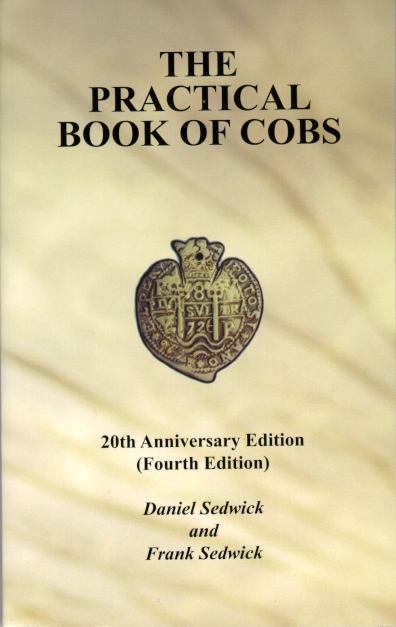
REVISED
&
BACK IN PRINT!
The
Practical Book of Cobs
by Daniel & Frank Sedwick
|
This popular
book has been out of print since 1995
and unavailable for a number of years
now, so this [fourth] edition should be
a most welcome addition to the market!
Greatly expanded from the previous
edition (more than 100 pages longer!),
this 20th Anniversary Edition contains a
long new section on the shipwrecks that
have yielded cobs over the years,
complete with a foldout map and
specified bibliographies for each wreck.
Also, the assayer section incorporates
the latest research information, with
specimen photos of most of the assayers
(not separated into a photo section as
before). The values in the back, of
course, have been updated. What has not
changed, however, is the appeal to both
beginners and advanced collectors alike,
as well as dealers and jewelers who work
with cobs.
The Practical
Book of Cobs offers readers a look at the
following topics:
Historical
background / Elements of design / Market
values / Extensive bibliography /
Complete ID of mint marks, assayers, and
period / How cobs were made and used /
Treasure Fleets and other shipwrecks
that produced cobs / How to buy and
sell, and how to spot counterfeits.
Soft
cover, perfect binding, 8.5” x 5.5”
format, 253 pages. Order directly from
the author: Daniel Frank Sedwick / P. O.
Box 1964 / Winter Park, FL 32790-1964 /
USA; PH: 407-975-3325; FAX:
407-975-3327; or www.sedwickcoins.com.
$25.00 plus shipping: $2.00 by Media
Mail; $5.00 by Priority Mail; $16.00
Express Mail...in the US.
Foreign: Please e-mail or call for exact
rate. |
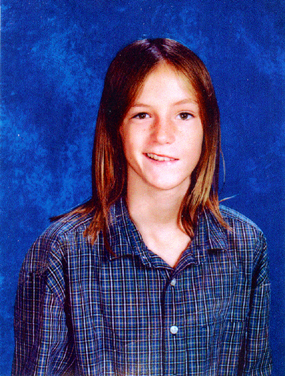
MICHAEL
CHRISTOPHER
ABT, JR.
3
November 1993—10 March 2006
“Michael
Christopher
Abt, Jr., without any warning, died of
Sudden Cardiac Arrest (SCA) on March 10,
2006 at the age of 12 years. He was a
perfectly healthy, happy, active and fit
young man. The day he died, he was on
the PE field at his school, and he just
collapsed onto the ground.
“It is for this reason that my husband
Michael Sr. and I have started a trust
fund in the name of our son, “The
Michael Abt, Jr. Have A Heart Fund” to
provide AEDs (Automatic Emergency
Defibrillators) to public schools
nationwide. It is our belief that this
simple machine may have been able to
save Michael’s life. The funds from this
foundation will provide AEDs to schools
which do not already have them as well
as secondary units to schools with large
campuses. These devices weigh less than
two pounds and cost approximately $1,500
each.
“Just as important as the presence of
the AED is the necessity to educate the
staff of the schools in how to maintain
and use them. The funds raised for this
foundation will also provide advanced
education for school health aides (who
are grossly underpaid) and training for
all school staff in the use of these
life-saving machines. It is said that
they are so simple to use that a
ten-year-old could learn to operate one
in less than ten minutes. The key to
successful use of an AED is a plan of
action.
“If you wish to donate to this fund, an
account has been set up with the Indian
River National Bank in Sebastian,
Florida. Checks should be made out to
“The Michael Abt, Jr. Have A Heart Fund”
and could be mailed directly to the bank
or to the address below.
“If you are unable to donate to this
fund, we understand completely. However,
whether you decide to donate to this
fund or not, we urge any of you who
volunteer, visit, teach, administrate,
or have children, grandchildren, etc.
who attend public schools to get
involved in your community to ensure
that these devices are available at your
schools, that staff is trained in their
use, that the AEDs are maintained in an
easily accessible area well known to all
possible operators, that batteries are
checked on a weekly basis and, most
importantly, that a ‘Plan of Action’ is
in place.
“We hope that no one on Earth EVER has
to experience this tragic heartbreak
again. The next life saved could be
someone you love.
“For links on how to get involved, visit
http://www.parentheartwatch.org, or
Google: ‘parent heart watch.’
”
Sincerely,
Taffi and Michael Abt and Family
Michael
Abt, Jr. Have A Heart Fund
c/o
Mel Fisher Center
1322
U. S. HWY #1
Sebastian,
FL 32958
|
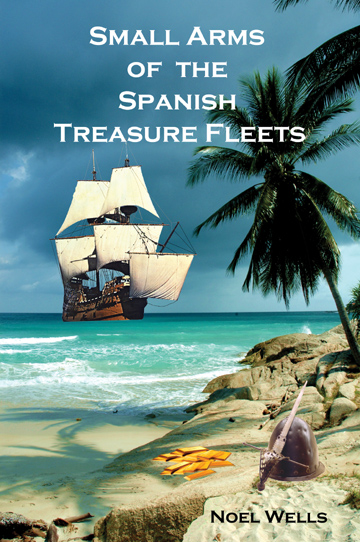 NEW
BOOK: NEW
BOOK:
SMALL
ARMS OF THE
SPANISH
TREASURE FLEETS
by Noel Wells
At last! Someone has
written a book whose subject is focused
on the weapons that the conquistadors
held when they overran the New World
inhabitants, that the Indigenous Peoples
fought back with, and that the soldiers
and sailors of the galleon fleets used
to repel boarders...and quell mutinies!
From artifacts recovered on the many
Spanish wreck sites in the Americas come
studies, photos, and sketches describing
the hand-held weaponry used in the
periods of conquest and colonization in
Spanish America, how they were built and
decorated, and how they were used in
practice.
Small Arms of the Spanish Treasure
Fleets, in 6” x 9” format, contains 192
pages filled with cogent text, accented
with 204 b&w photos and sketches.
Hardbound, the book is priced at $30.00
plus $3.50 postage (Media Mail) or $6.50
(Priority Mail). [Autographed by
Author.]
AVAILABLE
NOW. Order from:
ERNIE RICHARDS
P. O. Box 1698 West Palm Beach,
FL
33402-1698
USA
|
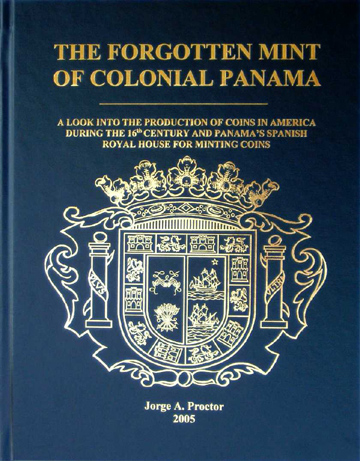 NEW
BOOK:
THE FORGOTTEN MINT OF COLONIAL
PANAMA NEW
BOOK:
THE FORGOTTEN MINT OF COLONIAL
PANAMA
by Jorge A.
Proctor
You
have read about the short-lived, early
mint of Panamá in PLVS VLTRA Newsletter,
and you have also read about the coming
of a book dedicated to that Spanish
colonial casa de moneda. It is
now a reality. Not since Pradeau and
Nesmith wrote their books on the Mexico
mint, and not since Sellschopp,
Paoletti, and others published their
works focused on the key mints in
colonial Peru, has a book about a
specific mint been so comprehensively
and meticulously constructed as this
one.
Its author, Jorge A.
Proctor, doggedly searched the national
archives in Seville for the long-lost
details of the primitive workings and
output of the minting house which
operated in his native Panamá in the
1580s. His research included studying
and documenting each of the 40-some
known surviving specimens of coinage
from this early effort —many “in person”
and some by photographic representation.
This was a Herculean task, taking up
much of his available time and
dedication for several years.
The
pages between these gold-embossed, black
hardbound covers are a fountain of
knowledge on his subject, expertly
presented and superbly illustrated with
photographs and diagrams of each of the
known types, denominations, and
variations of Panamanian cobs. Further,
Proctor has included excellent
photocopies of many of the ancient
documents —plus their translations into
modern Spanish— which were critical to
his study. Text is in English.
Illustrations are in both color and
monochrome, color shots of the coins
being used wherever possible. This book
is an object of physical beauty as well
as an historical and educational
resource, no expense having been spared
in its design and construction. Kudos to
our friend Jorge Proctor!
In
8.5" x 11" format, the book consists of
329 info-packed pages. Only 150,
consecutively-numbered copies were
printed, making it urgent that one
secures a copy now … as these will move
quickly. SORRY! ALL SOLD OUT.
Please search the Internet for used
copies!
Selling
at $135.00 each, plus postage, there is
only one outlet for this scholarly opus.
Order from Daniel Frank Sedwick / P. O.
Box 1964 / Winter Park, FL 32790-1964.
PH: 407/975-3325. Your request can also
be processed at:
http://www.sedwickcoins.com
|
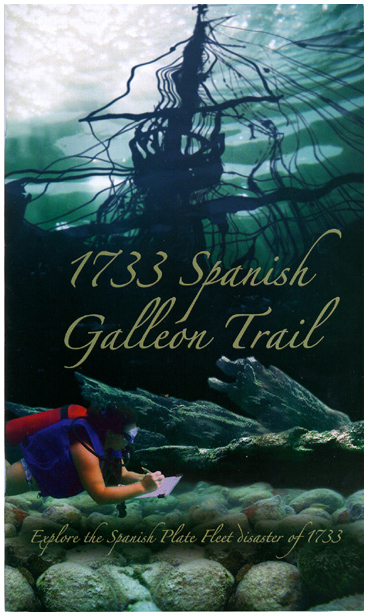
STATE of FLORIDA
Division of
Historical Resources
Bureau
of Archaeological Research
Has
just released a new pamphlet in honor
of our earliest settlers and
commemorating Hispanic Heritage Month,
September 15 through October 15, 2005.
This 24-page, full-color publication
takes the reader on the underwater
trail of the various wreck sites of
the Spanish Treasure Fleet ships
destroyed in the Florida Keys during a
hurricane in 1733.
Titled 1733 SPANISH GALLEON
TRAIL, the cover invites one
to “Explore the Spanish Plate Fleet
disaster of 1733”.
<>
To request
your copy of this milestone
publication, contact the Bureau of
Archaeological Research
500
S. Bronough Street / Tallahassee, FL
32399-0250
Or
e-mail Ryan J. Wheeler:
rjwheeler@dos.state.fl.us
Web
Site:
http://dhr.dos.state.fl.us/archaeology/
underwater/galleontrail/
OUT
OF PRINT...CHECK THE
INTERNET
FOR "PREVIOUSLY-READ" COPIES!
|
"FROGFOOT"
PUBLISHES
NEW BOOK (Last Before His Passing)
|
TRUE
STORIES of Sunken Treasure: The
Best of Bob “Frogfoot” Weller
is a collection of his
favorite short stories.
In
his style of “yarning ashore,” Bob
tells sixteen of the sagas he has
written over the years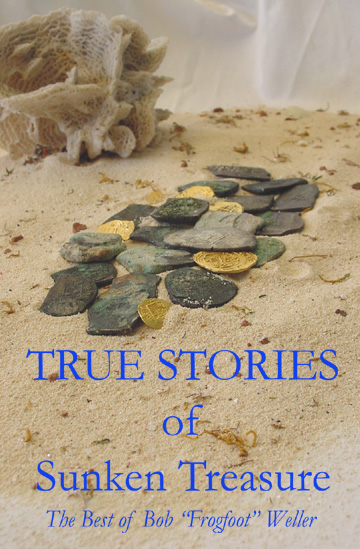 —those
which still fire him up when he
reads them again. From ships
“wracking” in the “Caribees” ... to
Spanish riches still to be found in
Florida waters ... to gold and
silver coins retrieved from the
sands of time along the “Treasure
Coast” —during a hurricane!—
“Ol’ Frogfoot” is at it again (for
the NINTH time), writing true and
exciting stories of treasures lost
and treasures found ... his first
new book since 2001.
Many of the
tales between these covers —filled
with danger, intrigue, and greed—
have never been told before, not by
“Frogfoot” ... not by anyone. The
maps associated with a few of these
stories should encourage readers to
“get it all” or “get the rest” of
the sunken treasures sure to be
where he says they are.
TRUE STORIES of Sunken
Treasure... ISBN
1-893758-01-X, is being published by
Crossed Anchors Salvage and will be
available as of 10 MAY 2005.
COST: $15.00 plus $3.00 p/p (slow)
or $5.65 (Priority).
Order from: Crossed Anchors
Salvage / 1818 17th Ave., N. / Lake
Worth. FL 33460. —those
which still fire him up when he
reads them again. From ships
“wracking” in the “Caribees” ... to
Spanish riches still to be found in
Florida waters ... to gold and
silver coins retrieved from the
sands of time along the “Treasure
Coast” —during a hurricane!—
“Ol’ Frogfoot” is at it again (for
the NINTH time), writing true and
exciting stories of treasures lost
and treasures found ... his first
new book since 2001.
Many of the
tales between these covers —filled
with danger, intrigue, and greed—
have never been told before, not by
“Frogfoot” ... not by anyone. The
maps associated with a few of these
stories should encourage readers to
“get it all” or “get the rest” of
the sunken treasures sure to be
where he says they are.
TRUE STORIES of Sunken
Treasure... ISBN
1-893758-01-X, is being published by
Crossed Anchors Salvage and will be
available as of 10 MAY 2005.
COST: $15.00 plus $3.00 p/p (slow)
or $5.65 (Priority).
Order from: Crossed Anchors
Salvage / 1818 17th Ave., N. / Lake
Worth. FL 33460.
|
|
07 DEC 2004
Dear Ernie:
The Historical Society of
Martin County is submitting a
grant application to the state of Florida requesting
funding
for a survey to be completed of
the historic shipwrecks in the
Treasure
Coast
area. The outcome of this survey will
educate residents and visitors of the
significance of Florida’s
Gulf Stream
relating to the history of the worldwide
shipping industry.
However, the ultimate goal of
this survey is to locate the final
resting place of Jonathan Dickinson’s
ship Reformation, which
wrecked off the shores of the Jupiter
Island
area in 1696. The story of
Jonathan Dickinson is a significant part
of Florida’s
history and Dickinson’s
eventual
arrival in Philadelphia,
where he became Mayor, makes it a
significant event in the history of our
country.
Locating Reformation
will enable us to more accurately
interpret his journal allowing
historians and future historians to
document Florida’s position in relation
to American history, and will provide
endless educational opportunities
through museum exhibits, educational
outreach programs for school children
and adults, as well as tourist
kiosk-type displays throughout the
community, and even allows the
possibility of eventually establishing
Jonathan Dickinson’s trail allowing
hikers and tourists to follow the
journey Dickinson literally took up
Florida’s East coast.
For more information about
how you can support this proposal please
contact:
Renee Booth
Martin
County
Historical Society 825
N.E.
Ocean
Boulevard
Stuart,
FL 34996-1696
PH: 772-225-1961 ext. 110
E-mail: ReneeLBooth@aol.com
|
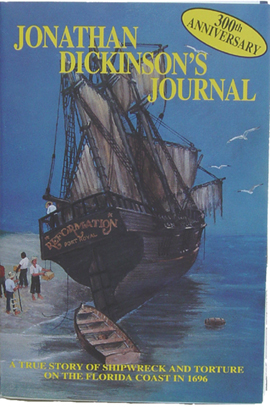
Jonathan
Dickinson's Journal
May be ordered
through this web site or from Florida
Classics Library
P. O. Box 1657
Port Salerno, FL 34992-1657
PH: 772-546-9380
|
TAMPA
TREASURE AUCTION
The Colombian Connection
PROLOGUE
The final chapter in a 20-year-old saga
was lived out on Wednesday, 25 June
2003, in Tampa, FL. The personal
“collection” of treasure confiscated
from a notorious South Florida drug
dealer was auctioned off at the Radisson
Riverwalk Hotel on Ashley Drive in that
city.
Thomas Ruck, with links to the Cali
drug cartel of Colombia, relinquished
his prizes along with a guilty plea, for
a lighter sentence. Indicted in 1993 on
drug trafficking charges, Ruck jumped
bond and was not apprehended again until
his arrest in 2001 in Hawaii.
Serving a 12-1/2-year stretch in the
Taft Federal Prison in California, Ruck
admitted, “They were looking for a very
substantial forfeiture; I decided rather
than get life in prison, I’d give them
everything I had.” “Everything” included
the treasures, a Ferrari Testarossa,
three Harley-Davidson motorcycles, and
$300,000 in cash.
The treasures sold on the 25th
consisted of an 87-pound silver bar from
the Atocha, six gold ingots and
nuggets, a gold and diamond brooch, a
gold chain, a cluster of gold and silver
coins, a gold coin “cocooned” in coral,
an ornate gold “candlestick,” 196 gold
coins from Spanish colonial mints, and
280 U. S. $20 gold pieces. All but the Atocha
bar and the U. S. coins came from the
sunken Spanish treasure fleet of 1715 in
Florida.
Ruck admitted to excavating the 1715
treasures in the 1980s—along with four
other divers— from a site on Florida’s
east coast, which he declined to
disclose. He feels that when and if he
gets out of prison he might return to
the area and continue to search for
treasure.
|
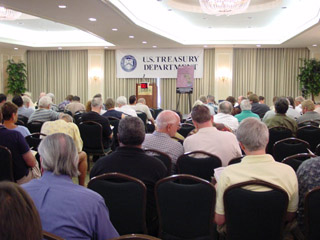
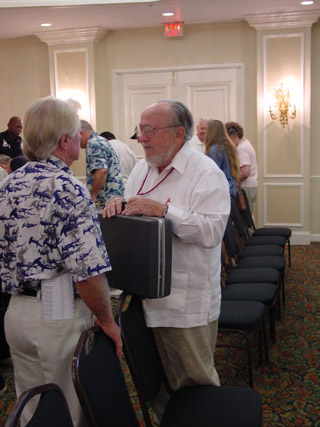
TOP: The Auction
Hall.
BOTTOM: Whitey Keevan,
Alan Craig discuss treasures.
|
| THE AUCTION
The sale was vigorously and efficiently
conducted by personnel associated with
EG&G Technical Services, based in
Manassas, VA. An estimated 450 people
attended the auction, with 228 of them
actually becoming registered bidders.
When the 233 seats were filled, the
balance of the observers lined up along
the walls and hung out in doorways in
the crowded auction hall.
Several people there who make their
livings selling coins and artifacts
included (in no special order) Taffi
Fisher, Kim Fisher, Paul Karon, Mike
Dunigan, Charles Adams (Cayman Islands),
Danny Lee, Mel King, and Dan Sedwick
(who was the official appraiser and
certifying authority for the Spanish
material). Notable divers, historians,
and others to be seen at the event
included Dr. Alan Craig; Atty. Dave
Horan; Bob, Margaret, and Rob Weller;
Carl Ward; Whitey and Jackie Keevan;
Buddy Martin; Dominic Addario; Rodney
Grambo; and Steve Atherton.
|

Bob "Frogfoot" Weller
in action...at the auction!
(How did he take all
these photos and bid too?)
|
| SOME STATISTICS
The Treasury Department’s take for the
day was $761,500. Some of the items sold
went as follows: 1715 4.1-pound gold
ingot, $18,000; 1715 gold “candlestick,”
$16,000; a 1703 dated Lima 8 escudos,
$13,250; and an Atocha silver
bar, $8,300. The 1715 fleet gold coins
sold between $900 and $13,250, and the
U. S. gold coins brought an average of
$475 each, mostly in lots of several
pieces.
Kim Fisher of Key West was quoted as
saying he had bought about 60 of the
gold coins from the 1715 fleet, his
sister Taffi (of the Mel Fisher Center
in Sebastian) was there to collect data
on what coins and artifacts were selling
for and only made one unsuccessful bid.
Whitey Keevan went home with a 7-ounce
gold disk for his collection, Bob Weller
brought back the clump containing two
“Bogie Two’s” and a number of silver
coins —plus 14 of the gold coins from
the 1715 fleet, and a mysterious man
known only as “Caribbeus” wound up
winning the 1703 Lima 8-escudo
coin.
The complete results of the auction are
scheduled be posted on the government
website 30 days after the date of the
sale. Go to: www.treas.gov/auctions/customs/coins.html
ALL FOTOS BY
FROGFOOT
REFERENCES:
“Caribbeus,” personal
observations via e-mail and telephone,
27 June 2003.
Schouten Cory.
“Once-In-A-Lifetime Auction: Bidding
on Bullion,” article in the St.
Petersburg Times, Thursday, June 26,
2003. I-net: www.stpetetimes.com
Silvestrini, Elaine.
“Silver Smiles, Golden Deals,” article
in the Tampa Tribune, Thursday, June
26, 2003. I-net: www.tampatrib.com
U. S. Treasury
Department. “Seized Shipwreck
Artifacts and U. S. and Spanish
Colonial Gold Coins,” Auction Catalog
of Wednesday, June 25, 2003.
Weller, Bob “Frogfoot,”
personal observations via e-mail and
telephone, 27 and 28 June 2003.
|
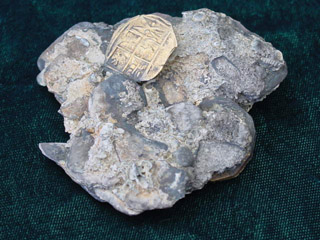
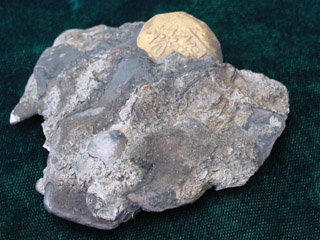
TOP: One of the
Bogotá 2 escudos in a clump
containing two, plus
numerous silvers.
BOTTOM: The other
"Bogie-Two" peeking out
of the matrix.
|
A GATHERING OF EAGLES:
THEY SHOWED US THE WAY
Monday, 19 May 2003, was one of
the most memorable days in the life of a
treasure diver (or a wannabe). On short
notice, Taffi Fisher-Abt and Bob
“Frogfoot” Weller had organized a famous
author book signing at the Mel Fisher
Center in Sebastian, FL.
Taking advantage of John S. Potter, Jr.’s
visit to Florida (and his patience and
benevolence), Taffi announced at the
State—Salvor annual kick-off meeting
almost three weeks earlier the possibility
of such an event. Bob Weller and yours
truly sent out e-mail invitations (to
those whom we felt would be within reach)
to come to MFC at 2:00 p.m. on the 19th
“with your copy of The Treasure Diver’s
Guide” and have it autographed by Potter.
Other authors, Dave Horner (The Treasure
Galleons +…) and Dave Crooks (Bibliography
of Sunken Treasure Books) were
specifically encouraged to participate in
the happening, though they lived in
Maryland and Illinois, respectively …and
participate they did! Horner was available
to sign copies of his SHIPWRECK: A Saga of
Sea Tragedy and Sunken Treasure and Crooks
for “Dave’s Bib.” The MFC gift shop had
plenty of copies of “Potter’s Guide” and
“SHIPWRECK…” (plus six of “Frogfoot’s”
titles) on hand for those who did not
already have these works in their
libraries.
Potter was accompanied by his son, John
S. Potter III (Johnno), also an avid
treasure diver and future author, and
after a breakfast with them and the
Wellers, the five of us embarked on
our trek from Lake Worth to Sebastian in
the Weller “Conestoga.” After a light
lunch at “Captain Hiram’s” in Sebastian we
returned to the MFC reception room (gift
shop), and the signing began in earnest
(that’s me, the autograph hog).
|
 
|
|
LEFT: Having lunch
at Captain Hiram's in Sebastian, left to
right, are Bob Weller, Margaret Weller,
"Johnno" Potter, Ernie Richards, and
"The Treasure Diver's Guide" author,
John S. Potter, Jr.
RIGHT: At the Mel
Fisher Center Gift Shop, Johnno
Potter, John Potter, Ernie Richards,
Bob Weller, Dave Horner, and Margaret
Weller mug for this photo-op.
PHOTOS COURTESY: John
Harkins / Zack Magnusson.
|
First in line, I asked Potter to sign five
of the books in my collection…one each of
five of his titles. Then I stepped aside as
the room filled and people queued up for
signatures. Besides those mentioned, other
notables were also taking advantage of the
opportunity to meet and greet John S.
Potter, Jr., a true northern
gentleman.
Bill Moore (finder of the Atocha gold
bars and MFC’s data coordinator), Greg
Bounds (one of MFC’s resident salvage
captains), and Harold Holden (a real
treasure-diving presence on the Treasure
Coast) were among the luminaries
participating in this historic event.
Co-incidental or otherwise, a TV film crew
arrived in the “nicotine” to videograph
the gathering. John Harkins and Zack
Magnusson (Blue Water Films), in Florida
shooting scenes for an upcoming series on
the Outdoor Channel, covered the event
from all angles and with digital still
cameras as well.
The turnout was moderate—considering it
was during the workweek and mildly
publicized—but it was fruitful and
exciting. To hear each of us tell J. S.
P., Jr., each of us in our own
perspective, how he had shaped our future
and careers was truly awesome and
enlightening. The genuine person that he
is, Potter apologized for having missed
the location of the Atocha in his book.
Well, so did everyone else researching
that wreck in the late 1950s and early
1960s! No apology necessary, John…Mel
found it.
|
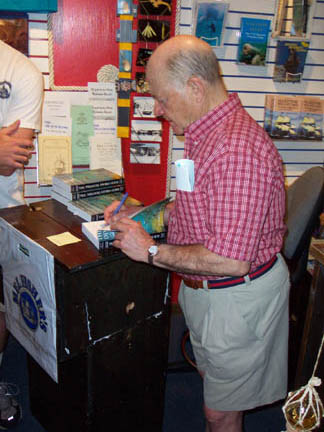 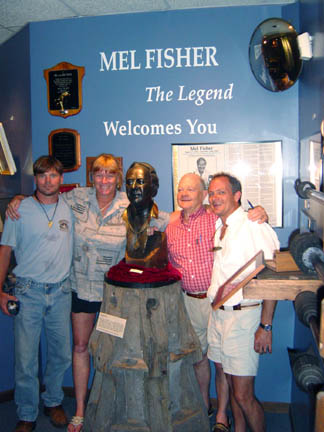
|
LEFT: John S.
Potter, Jr., the man who "showed us the
way," signs copies of his famous work
"The Treasure Diver's Guide" at the Mel
Fisher Center in Sebastian, FL.
PHOTO COURTESY: Dave
Crooks.
RIGHT: "Captain" Greg
Bounds, Taffi Fisher-Abt, John and
Johnno Potter pose with a bronze bust
of the "King of Treasure Divers," Mel
Fisher at MFC in Sebastian.
PHOTO COURTESY: John
Harkins / Zack Magnusson.
|
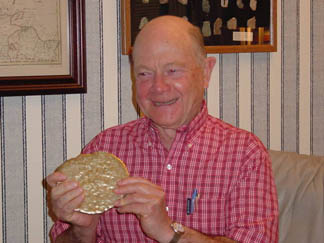 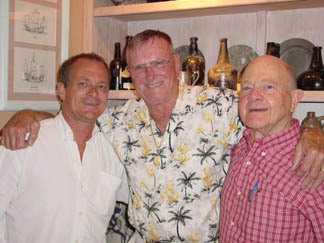
|
|
LEFT: John Potter
apparently enjoys the thrill of gold as
he holds a seven-pound gold disk
recovered from "Corrigan's Wreck" by
John Brandon and now part of the Weller
Collection.
RIGHT: At "Casa Weller"
Bob, The "Frogfoot," is bookended by
John S. Potter III (Johnno) and his
famous Dad John S. Potter, Jr. in
front of one of Bob's mini-museum
displays.
PHOTO COURTESY: Bob
Weller.
|
We (Potter’s welcoming committee) were
privileged to give him the (land) tour of
the 1715 wreck sites, which included a
pilgrimage to Kip’s Cabin (courtesy of Pete
Fallon) and a visit to the McLarty Treasure
Museum on the site of the 1715 survivors’
camp…none of which he had previously
experienced. During our comfortable cruise
home (we were in no hurry to part company),
the Wellers, the Potter gents, and I swapped
sea and life stories. It is amazing how our
individual lives had paralleled and crossed
paths over the past decades.
Back in Lake Worth, I took my leave of
this enjoyable company and went home to my
bride and cats. I understand that John,
Johnno, Bob, and Margaret enjoyed the rest
of the day at “Casa Weller” viewing part
of Frogfoot’s collection of shipwreck
treasures. A diving trip the following day
for the four of them had to be cancelled
due to the sea state, and the Potters
continued on down to Key West to meet with
Kim Fisher and company on Wednesday.
It was great!
GOOD HUNTING!
Ernie Richards
|
|
TROUBLE IN
THE FLORIDA KEYS: NOAA OFFERS RIGHTS
TO KEYS SHIPWRECKS TO SPAIN!
|
| Pat Clyne, our Defender
of SalvageRights, posts a
"net-note" announcing that one of our US
Government agencies now wants to ask Spain
if it's OK with them if we dive on merchant
ships which sank in Florida in 1733!
Follow the forum on the Mel Fisher site: www.melfisher.com/bbfram.html
-- look for "Welcome to the US, a
Territory of Spain." And read more
commentary at: www.treasuresites.com/news.htm
. |
******************************
SHIPWRECKS / TREASURE...
******************************
"PILLAR
DOLLARS" IN BRIEF...
In response to an inquiry from reader Jerry
Wilkinson, Florida Keys Historian.

|
In the world of SPANISH
COLONIAL COINAGE, one of the most
interesting and important areas of
study is that of the “king of coins,”
the pivotal piece that was to forever
alter methods of coin manufacturing in
this hemisphere and was to be the
model for monetary systems which are
still sound today—over 275 years
later: The Spanish
Milled Dollar! |
THE SPANISH MILLED
DOLLAR
by Ernie Richards
It is not difficult to imagine the thoughts that
occupied the mind of King Philip V of Spain as he
drafted the Royal Order of June 9, 1728. This
decree, to come into fruition four years later in
Mexico City, contained the instructions for
minting, perhaps, the single most important coin
ever in the history of the Western Hemisphere.
Philip must have dreamed of perfection and beauty,
much like Da Vinci or Michelangelo might have, for
the resulting coin was a masterpiece, a work of
art. He must have decreed that the new mintage,
designed to replace the functional but irregular
“cobs”, should be, each and every one, a medallion
honoring two hundred years of colonial coinage.
Not only is the Spanish Milled Dollar a work of
art, it is a testimonial as well. The story that
it tells is of Spanish entrepreneurs venturing out
into an unknown ocean because it was felt (due to
Columbus’ early voyages) that there was “more
beyond” (PLUS ULTRA). It brazenly displays the
“two worlds”, the old and the new, capped by one
Spanish Crown and riding on waves emanating from
between the Pillars of Hercules (Straits of
Gibraltar). This is a declaration that Spain
claimed dominion over both worlds and the sea in
between and that “both are one” (UTRAQUE UNUM).
Further emphasizing that belief is the legend:
PHILIP . V . D . G . HISPAN . ET IND . REX, which
declares that Philip the Fifth, by the Grace of
God, is King over Spain and the Indies.
The magnificently styled crowned Shield of Spain
adorning the reverse boasts the strength of the
union of the kingdoms of Castile and Leon and,
with the Bourbon Crest centered in the shield,
puts to rest any doubts that Philip’s family was
in control in the home country.
Although the irregular “cobs” were to continue to
be manufactured until late 1734, they were doomed
to total replacement by their royal bloodline
descendants, the Spanish Milled Dollars. Minting
of the new coinage was begun on March 29, 1732,
(in 8, 4, 2, 1, and 1/2-real denominations), after
the new dies and associated machinery arrived from
Spain. Not only were the dies of precision
quality, but the individual coins were no longer
struck by hand since a marvelous machine called a
“screw press” was introduced at this time
--transporting the coin industry from the Medieval
Era into the Age of the Industrial Revolution with
its mass-manufacturing technology. No longer was
each coin unique in size and shape; but, rather,
all coins were uniform...and beautifully so.
Each coin, by virtue of the new method of
manufacture, was of the same size, shape, weight,
and appearance. Additionally, another new process
was introduced at this time which thwarted the
common practice of “clipping” of coins; the new
series was manufactured with a “milled” edge. This
meant that by a special procedure, the edge of
each coin was imprinted with a wreath-like chain
of blossoms. Later coins, like most modern ones,
were supplied a “reeded” rim for the same purpose
of discouraging clipping.
The original design of the Spanish Milled Dollar
was produced from 1732 to 1772 and acquired many
nicknames along the way: Pillar Dollar; Piece of
Eight (a carryover); Two-World Dollar (and the
Spanish counterpart, Dos Mundos Dollar).
Such was the success of this design --especially
for its constant value (weight and silver
content)-- that it enjoyed the popularity of being
accepted as “coin of the realm” by several
European nations and American colonies. In the
pre-U.S. colonies, this fabulous piece was the
basis of what was to become the United States’
monetary system. It was officially recognized as
early as May 10, 1775, when the Continental
Congress issued its first paper currency payable
in “Spanish Milled Dollars or the value thereof in
gold or silver”; and the coin was officially
sanctioned for circulation in the United States
until 1857!
Interestingly, the existence of the coins dated
1732 and 1733 were virtually unknown to
numismatists worldwide because nearly the entire
two-year’s production of Pillar Dollars was being
carried to Spain in the ill-fated Plate Fleet of
1733 which was dashed to bits against the Florida
Keys by a hurricane. None again saw the light of
day until the 1960s, when treasure divers started
retrieving them and making them available to
collectors.
Adding to the numismatic value of the first two
years of issue of this coin, is the fact that two
variations were minted in 1732 and two more in
1733. The first type in 1732 was exactly as in
Figure-A, with the exception that nothing appeared
adjacent to the shield --no assayer’s mark and no
denomination. The second issue was as shown. In
1733, the coin featured assayer “F” coupled with a
mint mark of “M . X” in the first variation, which
was replaced later in the year with a combination
of assayers “M” and “F” and a standard “o/M” mint
mark. The latter was to remain the pattern for the
rest of the history of the Pillar Dollar. After
sometime in 1772, the pillars, waves, and two
worlds were replaced by a bust of the current
Spanish Monarch (adding “Bust Dollar” to the list
of nicknames), while the reverse remained
basically the same. The assayers for our period of
interest were:
1732 - 1733 Felipe (F) Rivas Ángulo
1733 - 1747 Francisco (F) de la Peña and
Manuel (M) de la Peña.
The rarest, and, naturally, the most valuable
issues of the Spanish Milled Dollar are the 1732
without a denomination or assayer’s mark; all
1732s; the 1733 with the “M . X” mint mark; and
the final year of issue, 1772.
In retrospect, if there were to be another single
silver coin engulfed in so much beauty and
historical significance, the first Mexican issues
of the Charles and Johanna series could
conceivably relegate the Spanish Milled Dollar to
second place...but it would be a photo-finish and
would not go uncontested. --EJR
(Article excerpted from PLVS VLTRA
Newsletter, 4th-Quarter, 1983.)
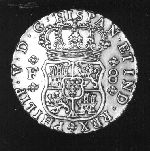
|
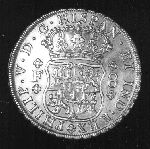
|
Above and Below.
The Mexican 1732-F 8R to be sold at
auction on 7-8 April in Chicago. Est:
$20-30,000!**
SOLD: $21,000... |
Above and Below.
The Mexican 1733/2-MX-F 8R to be
auctioned on 7-8 April in Chicago. Est:
$25-35,000!**
SOLD: $24,000... |

|
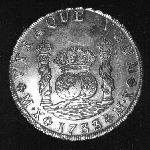
|
**Photos Courtesy of
Ponterio & Associates,
San Diego, CA. Call
800/854-2888 for
details of the auction &
mail bid sale.
******************************
Rings of the
1715 Spanish Treasure Fleet
by Bob “Frogfoot Weller
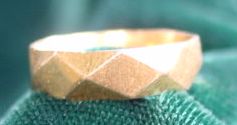
|
|
Gold Band of 1715.
Weller Collection.
|
All Fotos by Frogfoot.
Copyright 2001.
Beginning in May 1960 when
Kip Wagner’s “Real Eight” group first worked the
1715 Urca de Lima site about a mile north of the
Fort Pierce inlet, a great quantity of coins,
jewelry and artifacts have been recovered from the
various ballast piles of the 1715 Spanish Treasure
Fleet. By 1967 Kip and Mel Fisher’s group
“Treasure Salvors” had recovered literally
thousands of gold coins and well over a ton of
silver coins. So, when it comes to the salvage
community, it’s sort of “Ho-Hum” whenever a few
more gold or silver coins are recovered. But the
low and high karat rings being recovered are
another situation. The rings have more character
than coins…you see one coin you’ve seen them all,
even though each cob coin is different. Many of
the rings have stones: diamonds, emeralds,
sapphires, amethysts, and quite a few have been
recovered with engravings on them. Some rings are
circled with engravings of cannon, swords,
pistols, and probably belonged to the gunnery crew
on board. Other rings have dogs engraved, or
flowers, whatever fancied the engraver. Some of
the rings are unusual in their geometric design, a
design not seen for several hundred years.
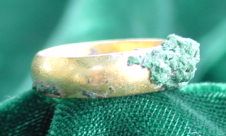
|
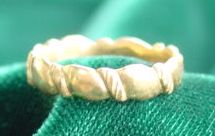
|

|
|
Plain Band
w/Silver Corrosion
|
Gold "Rope" Design
|
Band Of Etched
Circlets
|
All Fotos by Frogfoot. Copyright
2001.
The gold content of the
rings is also unusual. The high karat rings are
assayed out at 22.3 kt., the same as the gold
coins being recovered. For that reason they are
known as having “coin gold content”. The lower
karat gold coins vary from as low as 6 or 8 karat
gold to as high as 18 karat, and definitely have
considerable bronze or copper content. I recently
came across a ring recovered during some beach
erosion that appeared to be 100% copper, but I am
sure that is just a case of being burnished by the
sand as the ring washed in and out from the beach.
I also have a badly sulfided ring that in all
probability has considerable silver content.
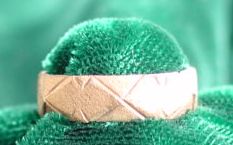
|
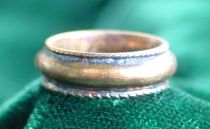
|

|
|
Engraved Chain of
Diamonds
|
Bronze "Two-Rope"
Design
|
Sulfided Silver
Band
|
All Fotos by Frogfoot. Copyright
2001.
Many of the rings were
recovered along the beaches after a storm by
ardent metal-detector-swinging beach hunters.
Nothing wrong with that, it’s healthy and keeps
the guys from being couch potatoes. There are even
a few female metal detector enthusiasts who brave
the pounding waves to snatch a glint of gold or
silver as it is uncovered. But for the most part
the many rings that have been recovered have been
on or around the ballast piles, or in the scatter
patterns that stretch along the reefs and sand
pockets just offshore.
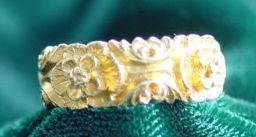
|
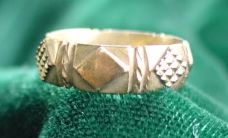
|

|
|
High-Kt "Olive
Blossom" Band
|
Carved Diamond
& Rope Motif
|
High-Kt,
3-Amethyst Beauty
|
All Fotos by Frogfoot. Copyright
2001.
My group “Crossed Anchors
Salvage” has been working the 1715 Spanish
treasure fleet since 1978, and over that period of
time we’ve recovered well over 90 rings, mostly
from the Nieves, that sank 2-1/2 miles south of
the Fort Pierce inlet. In 1993 we did recover 22
gold rings from the “Cabin Wreck” or almiranta of
the 1715 fleet, the San Roman. As I look back over
the recoveries I tend to agree with the rest of
the salvage community that the rings, in most
cases, were carried as cargo. One day I recovered
eight rings within an area no larger than a
kitchen table. Three years later, we revisited the
same area, and another diver, Bob Luyendyk,
recovered eight more rings also within a very
small space, about 15 feet from my own recovery.
We called this area “Ringsville,” because there
seemed to be a sort of swale, or low depression
between the reefs, in which we had recovered a
number of valuable rings. George Hook, one of our
divers, recovered a high karat gold ring with five
emeralds! And another diver, Don Kree, came up
with a beautiful high karat three-stone amethyst
ring! Photos of both rings are included in my book
Sunken Treasure on Florida Reefs.
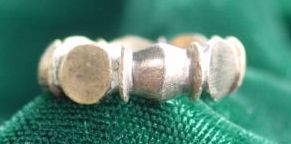
|

|

|
|
Low-Kt "Beaded"
Design
|
Plain,
Single-Amethyst Design
|
High-Kt "Chain of
Diamonds"
|
All Fotos by Frogfoot. Copyright
2001.
There is some speculation
that many of the more intricately engraved rings
were made in China, traded at the Manila fair, and
brought to Mexico by way of the Manila Galleons.
It seems that the Spanish artisans did not have
the capabilities during the 1600s and 1700s to
carve the ring designs, nor cut the emeralds and
diamonds that are found on the rings. The plainer
rings were possibly made by the local Mexican
artisans, as were the rings engraved with various
designs. These are indicative of Spanish
conquistadors, or sailors, with time on their
hands. Regardless, the rings are different in the
story they tell. Most of us in the salvage
community really do not believe that they graced
the finger, or fingers, of some Spaniard who
didn’t survive the 1715 hurricane. Again, this is
speculation…I wasn’t there. =Frogfoot=

|
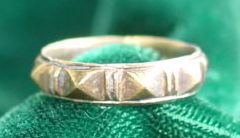
|
|
Carved,
Rimmed Circlets
|
"Pyramid-Style"
Gold Band
|
All Fotos by Frogfoot. Copyright
2001.
******************************
NUMISMATICS...
GOLD COINS FROM THE
1733 PLATE FLEET? YES!!
In response to charges
that Mel Fisher’s company in Key West had been
involved in the sale of several “fake” gold coins
of the 1733 era, Bob “Frogfoot” Weller has posted
a “rebuttal” on the internet. One of the
“incriminating facts” of the case against the
“King of Treasure Hunters” was statements by
well-known coin dealers and state officials to the
effect that “no gold coins were recovered from the
1733 Spanish treasure fleet!” It is this point
that Weller debates. He was “there” when many of
the gold pieces from that armada were recovered by
his diving buddies in the 1960s and afterward.
With photos as backup, and with depositions from
some of the other Keys divers, Ol’ Frogfoot
presents his case very well. If you have access to
the internet, do yourself the favor of visiting
the site and adding to your understanding of some
of the golden recoveries of the Spanish treasure
fleet of 1733.
Go to: http://www.apex-ephemera.com/treasure/rebuttal/
and page through some great narration.
******************************
RETURN TO
HOME >> |
 |
|






 —those
which still fire him up when he
reads them again. From ships
“wracking” in the “Caribees” ... to
Spanish riches still to be found in
Florida waters ... to gold and
silver coins retrieved from the
sands of time along the “Treasure
Coast” —
—those
which still fire him up when he
reads them again. From ships
“wracking” in the “Caribees” ... to
Spanish riches still to be found in
Florida waters ... to gold and
silver coins retrieved from the
sands of time along the “Treasure
Coast” —





















